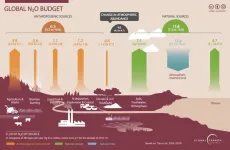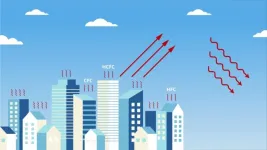(Press-News.org) Chestnut Hill, Mass. (6/11/24) – Emissions of nitrous oxide – a greenhouse gas more potent than carbon dioxide or methane – continued unabated between 1980 and 2020, a year when more than 10-million metric tons were released into the atmosphere primarily through farming practices, according to a new report by the Global Carbon Project.
Agricultural production accounted for 74 percent of human-driven nitrous oxide emissions in the 2010s – attributed primarily to the use of chemical fertilizers and animal waste on croplands – according to the report “Global Nitrous Oxide Budget 2024”, led by researchers from Boston College and published today in the journal Earth System Science Data.
In an era when greenhouse gas emissions must decline to reduce global warming, in 2020 and 2021 nitrous oxide flowed into the atmosphere at a faster rate than at any other time in history, the international team of researchers reported. On Earth, excess nitrogen contributes to soil, water, and air pollution. In the atmosphere, it depletes the ozone layer, and exacerbates climate change.
Agricultural emissions reached 8 million metric tons in 2020, a 67 percent increase from the 4.8 million metric tons released in 1980, according to the study, the most comprehensive study of global nitrous oxide emissions and sinks produced by a team of 58 researchers from 55 organizations in 15 countries.
“Nitrous oxide emissions from human activities must decline in order to limit global temperature rise to 2°C as established by the Paris Agreement,” said the report’s lead author, Hanqin Tian, the Schiller Institute Professor of Global Sustainability at Boston College. “Reducing nitrous oxide emissions is the only solution since at this point no technologies exist that can remove nitrous oxide from the atmosphere.”
The concentration of atmospheric nitrous oxide reached 336 parts per billion in 2022, a 25 percent increase over pre-industrial levels that far outpaces predictions previously developed by the Intergovernmental Panel on Climate Change, said Tian, director of the Center for Earth System Science and Global Sustainability at BC’s Schiller Institute for Integrated Science and Society.
“This emission increase is taking place when the global greenhouse gasses should be rapidly declining towards net zero emissions if we have any chances to avoid the worst effects of climate change,” said Tian, who coordinated the research on behalf of the Global Carbon Project.
The world’s farmers used 60 million metric tons of commercial nitrogen fertilizers in 1980. By 2020, the sector used 107 million metric tons. That same year, animal manure contributed 101 million metric tons for a combined 2020 usage of 208 million metric tons.
The unfettered increase in a greenhouse gas with a global warming potential approximately 300 times larger than carbon dioxide, presents dire consequences for the planet.
Drawing on millions of nitrous oxide measurements taken during the past four decades on land and in the atmosphere, freshwater systems, and the ocean, Tian said the researchers have generated the most comprehensive assessment of global nitrous oxide to date.
The researchers examined data collected around the world for all major economic activities that lead to nitrous oxide emissions and reported on 18 anthropogenic and natural sources and three absorbent “sinks” of global nitrous oxide.
The top 10 nitrous oxide emission-producing countries are: China, India, the United States, Brazil, Russia, Pakistan, Australia, Indonesia, Turkey, and Canada, the researchers found.
Some countries have seen success implementing policies and practices to reduce nitrous oxide emissions, according to the report. Emissions in China have slowed since the mid 2010s; as have emissions in Europe during the past few decades.
In the U.S., agricultural emissions continue to creep up while industrial emissions have declined slightly, leaving overall emissions rather flat. Natural sources of nitrous oxide emissions from soil, fresh- and saltwater have remained stable
Established in 2001, The Global Carbon Project analyzes the impact of human activity on greenhouse gas emissions and Earth systems, producing global budgets for the three dominant greenhouse gasses – carbon dioxide, methane, and nitrous oxide – that assess emissions and sinks to inform further research, policy, and international action.
Improved agricultural practices that limit the use of nitrogen fertilizers and animal waste can help reduce greenhouse gas emissions and water pollution. Tian said there is a need for more frequent assessments so mitigation efforts can target high-emission regions and activities. An improved inventory of sources and sinks will be required if progress is going to be made toward the objectives of the Paris Agreement.
“While there have been some successful nitrogen reduction initiatives in different regions, we found an acceleration in the rate of nitrous oxide accumulation in the atmosphere in this decade”, said Global Carbon Project Executive Director Josep Canadell, a research scientist at CSIRO, Australia’s national science agency. “The growth rates of atmospheric nitrous oxide in 2020 and 2021 were higher than any previous observed year and more than 30 percent higher than the average rate of increase in the previous decade.”
END
New study finds human-caused nitrous oxide emissions grew 40 percent from 1980-2020, greatly accelerating climate change
Absent technological solutions, agriculture sector – responsible for 74 percent of human-driven N2O emissions – must curb use of chemical fertilizer and animal manure
2024-06-12
ELSE PRESS RELEASES FROM THIS DATE:
Study reveals significant increasing nitrous-oxide emissions from human activities, jeopardizing climate goals
2024-06-12
Emissions of nitrous-oxide (N2O) - a potent greenhouse gas - have continued to rise unabated over the past four decades, according to an international team of scientists.
The new report 'Global nitrous oxide budget (1980–2020)' is published in the journal Earth System Science Data. It is the most comprehensive accounting to date of nitrous-oxide emissions from human activities and natural sources.
It was led by researchers from Boston College in the US and involved an international team of scientists including researchers from the University of East Anglia (UEA), UK, under the umbrella of the Global Carbon Project. ...
Virtual reality as a reliable shooting performance-tracking tool
2024-06-11
COLUMBUS, Ohio – Virtual reality technology can do more than teach weaponry skills in law enforcement and military personnel, a new study suggests: It can accurately record shooting performance and reliably track individuals’ progress over time.
In the study of 30 people with a range of experience levels in handling a rifle, researchers at The Ohio State University found that a ballistic simulator captured data on the shooters’ accuracy, decision-making and reaction time – down to the millimeter in distance ...
New study explores the sun’s effects on the skin microbiome – it can create a damaged skin barrier
2024-06-11
The impact of solar radiation on skin has long been understood but what about UV’s effects on our skin's hidden world – its microbiome?
An article from American Society for Photobiology’s journal delved into existing knowledge on solar radiation’s impact on the skin microbiome and proposed innovative sun protection methods that safeguard both skin integrity and microbiome balance.
Experts offered insights into novel sun protection products designed to shield the skin and mitigate the effects of solar ...
States declare May 17 as NEC Awareness Day
2024-06-11
The NEC Society is leading the way toward a world without necrotizing enterocolitis (NEC), a complex and often deadly intestinal disease affecting the most vulnerable infants. By bringing together families and elected officials, the NEC Society is raising the profile of this devastating neonatal disease. States nationwide have championed NEC Awareness Day Resolutions to recognize May 17.
The NEC Society’s families have partnered with elected officials to declare May 17 NEC Awareness Day in California, Colorado, Georgia, Louisiana, New York, Pennsylvania, and Utah, bringing much-needed attention to this leading cause ...
Precision medicine for sepsis in children within reach
2024-06-11
Sepsis – the leading cause of mortality in children around the world – can present with a wide range of signs and symptoms, making a one-size-fits-all treatment strategy ineffective. Pursuing a precision medicine approach for pediatric sepsis, researchers used artificial intelligence to analyze a large set of clinical data and find a distinct group of patients who might respond better to targeted treatments.
These children share clinical characteristics described as PHES, or persistent hypoxemia (abnormally low oxygen ...
New ACAAI position paper examines safety of receiving live vaccines while on dupilumab
2024-06-11
ARLINGTON HEIGHTS, Ill. (June 11, 2024) – A new position paper from the American College of Allergy, Asthma & Immunology (ACAAI) addresses the safety of administering live vaccines to patients who are currently being treated with dupilumab, a biologic therapy for various allergic conditions. The paper, The Use of Vaccines in Patients Receiving Dupilumab: A Systematic Review and Expert Delphi Consensus Recommendation: A Position Paper of the American College of Allergy, Asthma & Immunology, is published online in Annals of Allergy, Asthma & Immunology, ACAAI’s scientific journal. The panel conducting ...
St. Bernard Parish Hospital included among Becker’s 100 Great Community Hospitals
2024-06-11
CHALMETTE, La. – St. Bernard Parish Hospital (SBPH) has been named one of the 100 Great Community Hospitals in 2024 by Becker’s Hospital Review. This marks the second consecutive year St. Bernard Parish Hospital has earned the honor of being named a Great Community Hospital.
Many hospitals included on this year’s list have been recognized by rankings and rating organizations for their excellent clinical care, outstanding patient outcomes, and high performance in specialty services. Becker’s ...
Texas A&M receives grant from Inflation Reduction Act
2024-06-11
Texas A&M has been announced as a recipient of a $1.5 million grant from the Inflation Reduction Act to address climate-damaging hydrofluorocarbons.
The grant is among the five projects funded by the United States Environmental Protection Agency (EPA) totaling $15 million and includes three other universities: the University of Washington, Drexel University and the University of California- Riverside, along with the Air Conditioning, Heating and Refrigeration Institute.
Dr. Faruque Hasan, associate ...
Texas A&M researcher receives grant for work on phase separation
2024-06-11
Chemical engineering professor Dr. Jeetain Mittal has received a National Institutes of Health grant to support his work on phase separation.
Mittal’s research focuses on developing a multiscale computational framework to investigate the role of phase separation in biology, particularly in the formation of heterochromatin. Heterochromatin condensates are membraneless organelles that help control gene expression.
A key aspect of the proposal is the role of phase separation in chromatin organization, highlighting the need for new models in this area. Mittal’s ...
Wind from black holes may influence development of surrounding galaxies
2024-06-11
Clouds of gas in a distant galaxy are being pushed faster and faster — at more than 10,000 miles per second — out among neighboring stars by blasts of radiation from the supermassive black hole at the galaxy’s center. It’s a discovery that helps illuminate the way active black holes can continuously shape their galaxies by spurring on or snuffing out the development of new stars.
A team of researchers led by University of Wisconsin–Madison astronomy professor Catherine Grier and recent graduate Robert Wheatley revealed the accelerating gas using years of data collected from a quasar, a particularly ...
LAST 30 PRESS RELEASES:
Numbers in our sights affect how we perceive space
SIMJ announces global collaborative book project in commemoration of its 75th anniversary
Air pollution exposure and birth weight
Obstructive sleep apnea risk and mental health conditions among older adults
How talking slows eye movements behind the wheel
The Ceramic Society of Japan’s Oxoate Ceramics Research Association launches new international book project
Heart-brain connection: international study reveals the role of the vagus nerve in keeping the heart young
Researchers identify Rb1 as a predictive biomarker for a new therapeutic strategy in some breast cancers
Survey reveals ethical gaps slowing AI adoption in pediatric surgery
Stimulant ADHD medications work differently than thought
AI overestimates how smart people are, according to HSE economists
HSE researchers create genome-wide map of quadruplexes
Scientists boost cell "powerhouses" to burn more calories
Automatic label checking: The missing step in making reliable medical AI
Low daily alcohol intake linked to 50% heightened mouth cancer risk in India
American Meteorological Society announces Rick Spinrad as 2026 President-Elect
Biomass-based carbon capture spotlighted in newly released global climate webinar recording
Illuminating invisible nano pollutants: advanced bioimaging tracks the full journey of emerging nanoscale contaminants in living systems
How does age affect recovery from spinal cord injury?
Novel AI tool offers prognosis for patients with head and neck cancer
Fathers’ microplastic exposure tied to their children’s metabolic problems
Research validates laboratory model for studying high-grade serous ovarian cancer
SIR 2026 delivers transformative breakthroughs in minimally invasive medicine to improve patient care
Stem Cell Reports most downloaded papers of 2025 highlight the breadth and impact of stem cell research
Oxford-led study estimates NHS spends around 3% of its primary and secondary care budget on the health impacts of heat and cold in England
A researcher’s long quest leads to a smart composite breakthrough
Urban wild bees act as “microbial sensors” of city health.
New study finds where you live affects recovery after a hip fracture
Forecasting the impact of fully automated vehicle adoption on US road traffic injuries
Alcohol-related hospitalizations from 2016 to 2022
[Press-News.org] New study finds human-caused nitrous oxide emissions grew 40 percent from 1980-2020, greatly accelerating climate changeAbsent technological solutions, agriculture sector – responsible for 74 percent of human-driven N2O emissions – must curb use of chemical fertilizer and animal manure





